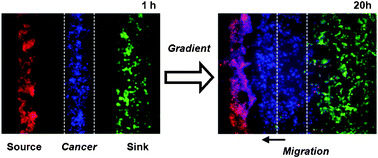Abstract

- This article is part of the themed collection: Mechanisms of directed cell migration
* Corresponding authors
a Department of Biomedical Engineering, University of Michigan, Ann Arbor, MI
b Department of Radiology, University of Michigan, Ann Arbor, MI
c
Department of Microbiology and Immunology, University of Michigan, A526 BSRB, 109 Zina Pitcher Place, Ann Arbor, MI
E-mail:
gluker@med.umich.edu
Fax: 734-647-2563
Tel: 734-763-5849
d
Department of Macromolecular Science and Engineering, University of Michigan, 2115 Carl A. Gerstacker Building, 2200 Bonisteel Blvd., Ann Arbor, MI
E-mail:
takayama@umich.edu
Fax: 734-936-1905
Tel: 734-615-5539

 Please wait while we load your content...
Something went wrong. Try again?
Please wait while we load your content...
Something went wrong. Try again?
 Fetching data from CrossRef.
Fetching data from CrossRef.
This may take some time to load.
Loading related content
